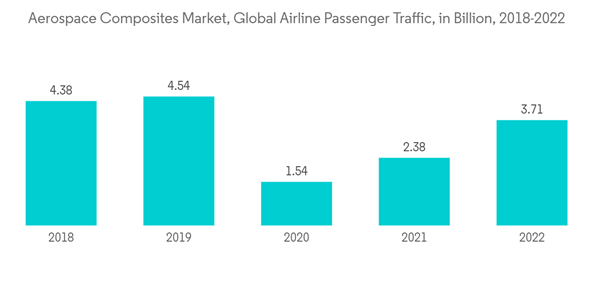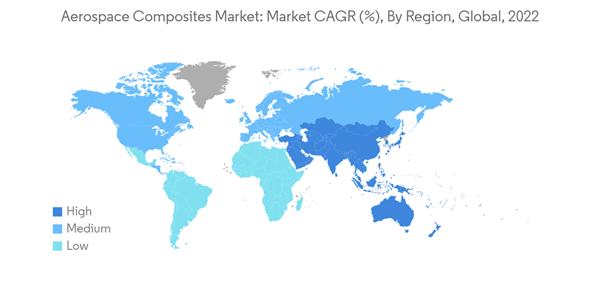The characteristics of composites, like temperature and chemical resistance, lightweight, high stiffness, dimensional stability, and flex performance, among others, made their use popular in various aerospace components and structural applications. Reduced maintenance, longer design life, fewer parts, and reduced tooling and assembly costs are some of the reasons that drive the aerospace composites market.
The substantial rise in passenger traffic and the imposition of new emission regulations led to a significant increase in demand for new-generation aircraft purchases over the last decade, before the pandemic. Aircraft manufacturers are developing new aircraft models in the commercial, military, and general aviation sectors, requiring newer engines with better performance and low weight. As a result, the emphasis on newer material technologies like composites is increasing.
Aerospace Composites Market Trends
Commercial Aviation Segment to Lead Market Share
The commercial aircraft segment accounted for the highest market share in the aerospace composites market during the forecasted period. With the increase in air passenger traffic, airlines started operating on all major routes and also added new routes. United Airlines announced that it started operating on new routes, describing it as its "largest transatlantic expansion." With everything returning to normal, new airlines started operations. Akasa Air, a new Indian airline, started its operations in August 2022, starting with one route with 28 flights a week and gradually adding two more routes. In October 2022, Alaska Airlines placed an order for 52 Boeing B737 MAX aircraft with a plan to expand its fleet. The airline announced plans to include an all-Boeing mainline fleet by the end of 2023.With e-commerce operations increasing rapidly since COVID-19, the air cargo market increased, and thus, the orders for freighter aircraft also increased in 2022. For instance, in October 2022, Luxembourg's Cargolux Airlines placed an order with Boeing for 10 B777-8 freighters along with options for 6 additional aircraft. China holds the position of second largest air freight market only next to the United States. According to Boeing's Commercial Market Outlook 2022, China's commercial air fleet is expected to grow from 3900 to 9600 by 2041.
Asia-Pacific Expected to be the Fastest-growing Market for Aerospace Composites During the Forecast Period
The Asia-Pacific became a significant hub for the aviation industry over the years. The emerging economies in the region, like India and China, are experiencing a massive surge in their respective civil aviation markets due to an increased demand for air travel. Hence, the revenues from Asia-Pacific are projected to witness a high growth rate during the forecast period. This high growth rate is the increasing procurement of aircraft with engines that use these composites. In the commercial sector, more than one-third of the commercial aircraft deliveries of two aerospace giants, Airbus SE and The Boeing Company combined, are to customers in Asia-Pacific. In May 2021, IndiGo, a major low-cost airline, announced that it selected CFM International 'LEAP-1A' engines to power its fleet of 310 new Airbus family aircraft delivered in 2023. The aircraft belong to different categories, including A320neo, A321neo, and A321XLR. The agreement includes 620 newly installed engines and associated spare engines and a long-term, multi-year service agreement. The Leap Engines used in the aircraft use a higher volume of composites than its predecessors.With the increase in military spending of the countries in the region due to tensions between neighboring countries and with foreign nations investing in arranging military base stations in countries like Australia, military aviation in the Asia-Pacific region is also increasing. For instance, in October 2022, India's first private consortium for the military - the Tata-Airbus consortium initiated the construction of a manufacturing facility to build the C-295 medium transport aircraft to modernize the Indian Air Force's transportation fleet. Factors such as these are driving the growth of the aerospace composites market in this region.
Aerospace Composites Industry Overview
The aerospace composites market is semi-consolidated, wherein prominent players in the market occupy the majority of the market share: Toray Industries Inc., SGL Carbon SE, Hexcel Corporation, Solvay SA, and DuPont. The partnerships of the companies with OEMs for the development of components and parts of the aircraft to increase the profitability of the end user are expected to open new market opportunities to the existing players. Also, investments of companies in advanced composites for space-based applications may help increase their market presence. For instance, in February 2023, Toray Industries Inc. supplied the Japan Aerospace Exploration Agency's (JAXA, Tokyo) H3 launch vehicle - the successor to its H-IIA rocket - with Torayca carbon fiber and prepreg. Such developments will be fueling the growth of the market during the forecasted period.Additional Benefits:
- The market estimate (ME) sheet in Excel format
- 3 months of analyst support
This product will be delivered within 2 business days.
Table of Contents
Companies Mentioned (Partial List)
A selection of companies mentioned in this report includes, but is not limited to:
- Bally Ribbon Mills
- Mitsubishi Chemical Carbon Fiber and Composites Inc.
- Toho Tenax Co., Ltd.
- Toray Industries Inc.
- SGL Carbon SE
- Hexcel Corporation
- Solvay SA
- DuPont
- Royal Ten Cate N.V.
- Materion Corp.










